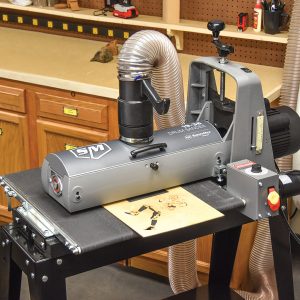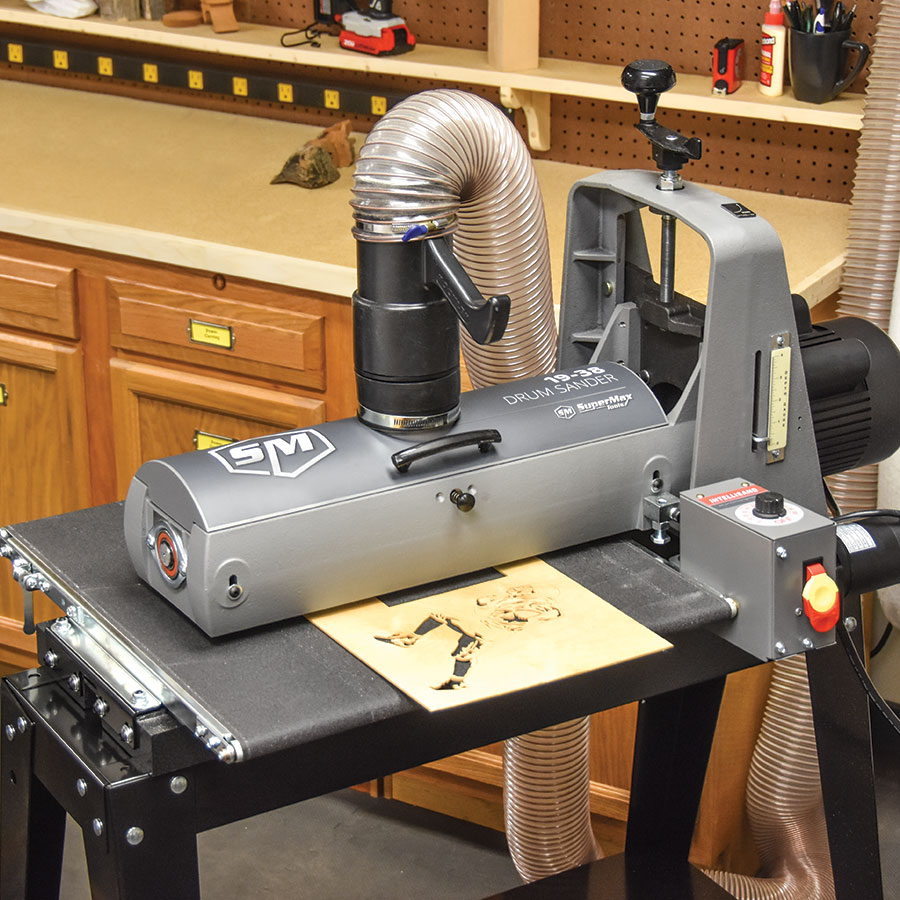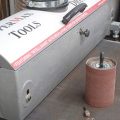 If you regularly work with thin blanks, and especially if you resaw your own stock, you probably need a drum sander. This tool can surface wood and reduce its thickness without damaging it.
If you regularly work with thin blanks, and especially if you resaw your own stock, you probably need a drum sander. This tool can surface wood and reduce its thickness without damaging it.
What is a drum sander?
Scrollers often use the terms “sanding drum” and “drum sander” interchangeably, but they are not the same tool. A sanding drum attaches to a rotary carver and is often used to shape intarsia or clean up small cuts. A drum sander has an abrasive-wrapped spinning drum attached to a precision-flattened table. On stationary drum sanders, a variable-speed conveyor belt moves lumber at a consistent speed under a spinning drum wrapped with sandpaper, allowing you to sand thin and short pieces of wood. The drum moves up and down using a screw drive, which allows you to create a perfectly flat surface and control the amount of wood removed in each pass.
Why do you need a drum sander?
Drum sanders allow you to quickly sand wide flat blanks, smoothing away any resaw marks or even planer marks. The drum sander smooths without cutting, which reduces the risk of damage to the blank. A planer has similar controls and works more quickly, but its blade can damage thin and/or figured wood. Additionally, unlike a planer, one side of the drum sander is open, allowing you to feed blanks larger than the drum through the sander. By sanding one half, refereeing it, and sanding the other half, you can sand blanks twice as wide as the drum.
When planing, you need to be aware of the grain direction of the wood; feed the wood with the planer cutting against the grain, and damage your blank. With a drum sander, you can feed the blank from either end without damaging the piece. With coarse-grit paper on the drum, you can remove wood quickly, but not as quickly as a planer. You also need to save extra wood to sand with finer grits to remove scratches from the coarser grits. The sander’s conveyor belt allows you to sand even the smallest pieces of wood, which is challenging to do with a planer without shop-made holding fixtures.
With finer grit paper on the drum, you can carefully remove small amounts of wood to smooth delicate projects. Carole Rothman, author and Scroll Saw Woodworking & Crafts contributor, users her drum sander to make sure bowl blanks are perfectly flat with parallel faces. You can even send small ornament blanks, and with a little practice even fretwork ornaments.
The “Dream Shop” Drum Sander
My top choice of drum sanders is the SuperMax 19-38. From the moment I opened the packaging I was impressed. The sander is shipped in thick custom-shaped cardboard boxes. All of the parts are held apart to keep them from banging into each other during transit. When it came time to assemble the sander, I was impressed with the solid stand and equally solid locking casters. The unit was easy to assemble with the included instructions; I had the sander put together in about an hour. Then, the instructions led you through a test to check that the conveyor table was parallel to the drum. My table was, but apparently things can get knocked out of alignment during shipping.
The alignment test also gives you a chance to try out the quick and easy sandpaper change system. It’s as simple as pinching a spring loaded clamp to release one end of the sandpaper, unrolling the sandpaper from the drum, and pinching another spring loaded clamp to free the other end of the sandpaper. When you go to reload the sandpaper, you insert one end as far as the taper will allow in the spring clamp, roll the sandpaper somewhat tightly around the drum, and clip the sandpaper in the other end. The spring loaded clips reeve the slack and tension the sandpaper on the drum automatically. I was shocked at how easy it was. While SuperMax sells pre-cut sandpaper rolls for the drum, if you save your spent rolls, you can use those rolls as a template to cut your own from the readily available rolls of sandpaper.
The sander comes with a 1 3/4 HP motor that seems powerful enough to keep the drum moving against even the hardest wood. It also features Intellisand technology that controls the speed of the conveyor. This technology detects when the motor starts to slow and automatically adjust the conveyor speed. This prevents any gouging, damaging, or burning of the blank, and gives you a constant finish even with grain and wood density changes. Overall, this speeds up the sanding process because you don’t need to be standing by listening for changes in the motor to adjust the conveyor speed. I couldn’t wait to try it. The sander came loaded with an 80-grit roll, so I immediately grabbed the rough-sawn piece of unidentified lumber shipped with the sander to support the drum head. I did a rough measure, and set the sander to that thickness. I turned it on, and while it took a few tries to dial in the thickness, I was impressed with the sanding speed. I turned the conveyor speed the whole way up, and intentionally set the sander to remove a healthy portion of wood. The conveyor sped up and slowed down as needed and the resulting surface was smooth and flat, without any operator action when it comes to adjusting the conveyor speed.
Taking off a lot of wood also gave me a chance to test the dust collection for the 19-38. The shape of the dust collection hood mirrors the shape of the drum, which helps collect the majority of the dust. It’s safe to say that the more wood you remove the more dust is create. Our shop dust collector, with a 650 CFM suction capacity, kept up with the sander and allowed only a small amount of fine dust to escape, under what I consider a somewhat extreme test. When I checked the dust collection under normal operations, I was hard pressed to find any dust not collected.This increases the usefulness of this sander as a scroller’s replacement for a planer.
I sanded everything from fragile fretwork portraits to thick slabs with no issues. Its 19″-wide table is open on one end, allowing you to sand wood up to 38″ wide in two passes. If you make custom frames or large panels, you need this sander. With the flat table, you can even use the tool to joint the edges of blanks less than 4″ wide. And, there is a quick release lever if you have a tapering blank that does get stuck under the drum. Flip the lever to instantly drop the conveyor table slightly to release the pressure.
Another of our contributors, Dave Van Ess, considers this tool a must-have. “I would put this as the first tool (after a scroll saw) a serious scroller would buy,” Dave said. Carole Rothman uses her SuperMax 19-38 for everything from dimensioning lumber to rescuing cupped and twisted wood and flattening and smoothing laminated blanks. Carole is impressed with the SuperMax 19-38’s quick and easy sandpaper changing system.The sander also allows her to transform scrap wood into the colorful veneers she uses to accent her bowls, baskets, and vases.
The SuperMax is available for around $1,399. Visit www.supermaxtools.com to find a retailer.






